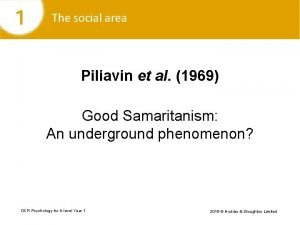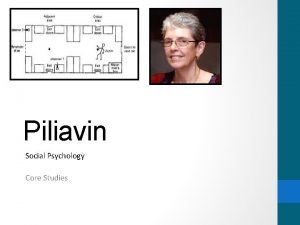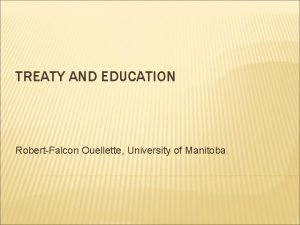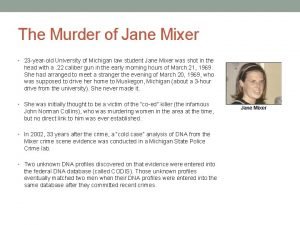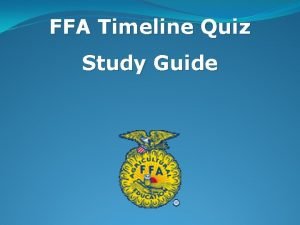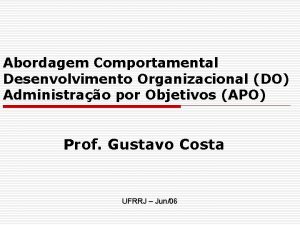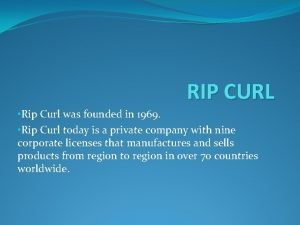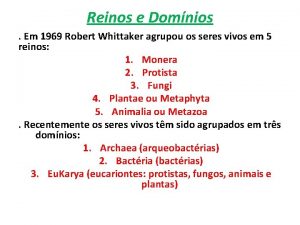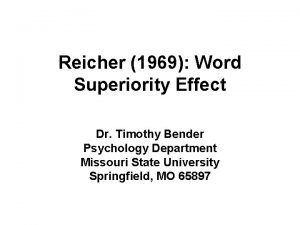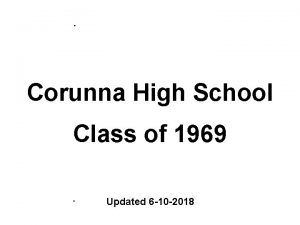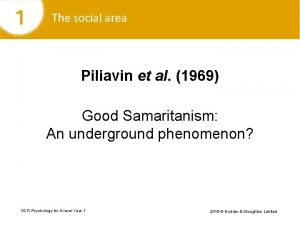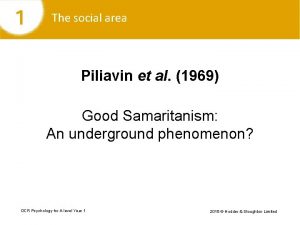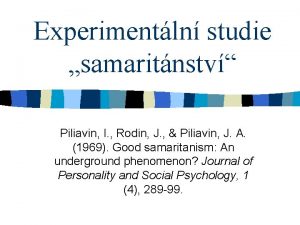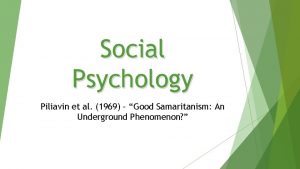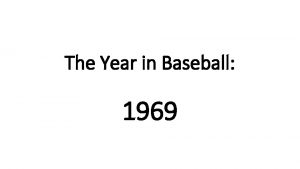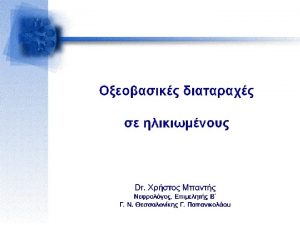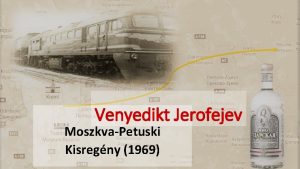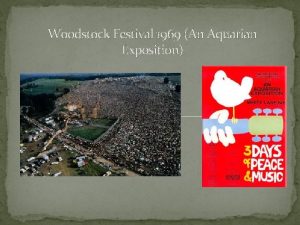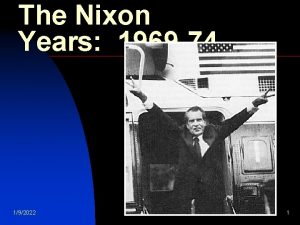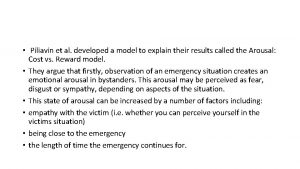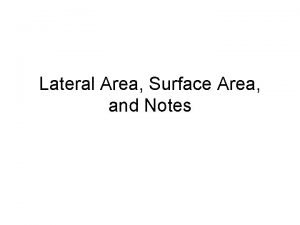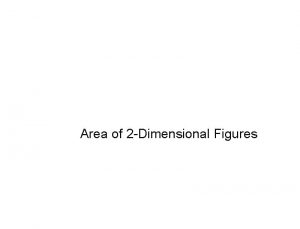The social area Piliavin et al 1969 Good






















- Slides: 22

The social area Piliavin et al. (1969) Good Samaritanism: An underground phenomenon? OCR Psychology for A level Year 1 2015 © Hodder & Stoughton Limited

The social area Background How helpful are you? • Try to write a list of three things you’ve done that have helped other people. • When you help someone, do you expect anything in return? • Doing a good deed without getting any reward is known as altruism. Some people argue that there is no such thing as altruism, as even if you don’t get anything physical, feeling good about doing a good deed is a reward in itself. What do you think? OCR Psychology for A level Year 1 2015 © Hodder & Stoughton Limited

The social area Would you help someone who was in trouble? • What would you take into account before jumping to help someone? • This study will investigate whether people help others due to true altruism, or if people are inherently selfish, putting themselves first before helping others. OCR Psychology for A level Year 1 2015 © Hodder & Stoughton Limited

The social area Kitty Genovese • Kitty Genovese was a 28 -year-old woman who was murdered in New York in 1964 after being attacked on three different occasions by the same man while she was walking home. • She was attacked in a residential area and several witnesses (an alleged 38 people) witnessed the attacks, but no one went to help her – or even called the police. The bystander effect is when a group of people does not offer help or assistance in any way when witnessing someone in need. OCR Psychology for A level Year 1 2015 © Hodder & Stoughton Limited

The social area The bystander effect The story was shocking and it led to several pieces of research to investigate ‘the bystander effect’. • • • Latane and Darley (1968) conducted a lab experiment where a participant would be put in a room and asked to fill out a questionnaire. As the questionnaire was being completed, smoke started filling up in the room. The participant was timed in how long before he/she will tell someone about the smoke. In the other condition the participant is filling out the questionnaire with a group of other people (actors). When the smoke comes in the room, the actors ignore it. Again it is timed to see how long it will take the participant to tell someone. Latane and Darley found that if participants were on their own, they would get help far more quickly than if they were in the room with other people. Why do you think this is? OCR Psychology for A level Year 1 2015 © Hodder & Stoughton Limited

The social area Diffusion of responsibility This is a theory that predicts that the more people there are in a situation, the less likely it is that a person in need will receive help. Everyone believes that someone else should help, so no one does anything. The Piliavin study built upon previous research that had been conducted in this area. As previous research had largely been lab experiments, this study was designed to have high ecological validity. OCR Psychology for A level Year 1 2015 © Hodder & Stoughton Limited

The social area Aim This study was designed to investigate how a group of people would react if they saw a person who collapsed on a train. Specifically they wanted to investigate: • Would an ill person get more help than a drunk person? (the type of victim) • Would people help others of the same race before helping those of different races? • If a model person started helping the victim, would that encourage others to also help? • Would the number of bystanders who saw the victim influence how much help was given? OCR Psychology for A level Year 1 2015 © Hodder & Stoughton Limited

The social area Hypothesis Piliavin et al. hypothesised that: • • A drunk person would get less help than an ill victim. People would help others of the same race first. Seeing a model person helping would encourage others to help. The larger the group, the less likely it is the victim will receive help. OCR Psychology for A level Year 1 2015 © Hodder & Stoughton Limited

The social area Method Sample • Participants were passengers who were on board the 8 th Avenue subway express train in New York. • They did not know they were taking part in a study, gave no consent and were not debriefed. • Approximately 4, 450 participants took part in the study over three months. • 55 per cent of them were white and 45 per cent were black. • The study took place daily on weekdays from 11 a. m. to 3 p. m. over three months. • The experiment always took place between the same two stops on the train as there was a 7. 5 minute period with no interruptions. OCR Psychology for A level Year 1 2015 © Hodder & Stoughton Limited

The social area Procedure • Using teams of university students, a situation was created on the train to see how passengers would react to it. • Seventy seconds into the journey, one of the university students would stagger forwards and collapse on the train. • The student would always collapse in the same spot – designated the ‘critical area’. The other side of the train was called the ‘adjacent area’. • Participants’ reactions were then watched by covert observers. OCR Psychology for A level Year 1 2015 © Hodder & Stoughton Limited

The social area Conditions The victim • In some trials the victim would appear ill and would hold a walking cane. • In other trials the victim would appear drunk, smell like alcohol and have a bottle in a brown paper bag. • The race of the victim would vary. Sometimes he was white and sometimes he was black. • The victim always wore the same clothes and was always aged between 26 and 35. OCR Psychology for A level Year 1 The model • In some trials a model (a researcher in disguise) would help the victim up. • The model would either help quickly (after 70 secs) or slowly (after 150 secs). • He would either be in the critical area or the adjacent area. Model conditions: • Critical area / Quickly • Critical area / Slowly • Adjacent area / Quickly • Adjacent area / Slowly • No model 2015 © Hodder & Stoughton Limited

The social area The researchers • • Four teams of university students ran the study for three months. Each team had two females and two males. The males always played the part of the victim and model. The females covertly observed the participants’ reactions from behind newspapers. Observers recorded: • The race, gender and location of passengers on the train. • The race, gender and location of passengers who helped the victim. • How long it took passengers to help the victim. • What passengers said to each other when they noticed the victim. At the end of the three months, the teams had conducted 103 trials on the train. Most of these were ill trials rather than drunk, though (they didn’t like doing the drunk trials). OCR Psychology for A level Year 1 2015 © Hodder & Stoughton Limited

The social area Results Piliavin et al. hypothesised that… 1. A drunk person would get less help than an ill victim. • Ill victims received help 95% of the time (62/65 trials). • Drunk victims received help 50% of the time (19/38 trials). 2. People would help others of the same race first. • Race did not really have a large effect on who helped whom. • Black victims received slightly less help, although this is not significant. 3. Seeing a model person would encourage others to help. • Models were rarely needed; the public usually helped quickly on their own. 4. The larger the group, the less likely it is the victim will receive help. • The number of bystanders made no difference to how many people helped. OCR Psychology for A level Year 1 2015 © Hodder & Stoughton Limited

The social area Other findings • It took passengers a median time of 5 seconds to help an ill victim. • It took a median time of 109 seconds for a drunk victim to receive help (without a model). What hypothesis does this support? Observers heard women saying: • ‘It’s for men to help. ’ • ‘You feel bad when you don’t know what to do. ’ OCR Psychology for A level Year 1 2015 © Hodder & Stoughton Limited

The social area Discussion One of the surprising findings in this study was that there was no diffusion of responsibility. The size of the group made no difference to how much help a victim received. Piliavin et al. offered several explanations for this: 1. Passengers were trapped on the train and could not really leave the situation. On the street the results may have been different. 2. It was less effort for passengers to help. If they were sitting on the train anyway and were waiting for the next stop they may as well help. 3. Unlike the situation with Kitty Genovese, it was clear what the problem was for the bystanders who were sitting next to the victim. OCR Psychology for A level Year 1 2015 © Hodder & Stoughton Limited

The social area How people respond to emergency situations Using data from the study, Piliavin et al. suggested a model that could explain how people respond to emergency situations. • It states that when bystanders are faced with a situation, a state of arousal is created (it could be fear, disgust, guilt, etc. ). This arousal makes us feel uncomfortable. • We want to get rid of that uncomfortable feeling of arousal and we can do this in different ways. • Either we can help the person, or we can leave the situation. • What we do depends on the costs and rewards of choosing whether to help or not. This model is called the arousal-cost-reward model OCR Psychology for A level Year 1 2015 © Hodder & Stoughton Limited

The social area The arousal-cost-reward model Costs Rewards OCR Psychology for A level Year 1 Helping Not helping Effort, harm, embarrassment Disapproval, blame, guilt, judgement Praise from others, feeling good about yourself Being able to continue your other activities, less effort 2015 © Hodder & Stoughton Limited

The social area Conclusion Piliavin et al. conclude that the reason why people choose to help is because they want to get rid of that uncomfortable feeling of arousal. So, according to Piliavin, are people altruistic or not? People are NOT ALTRUISTIC: Piliavin et al. state that helping is: ‘a selfish desire to get rid of an unpleasant emotional state’. OCR Psychology for A level Year 1 2015 © Hodder & Stoughton Limited

The social area Evaluation Do you agree with the conclusion of this study – or can you see any problems with the methodology? This study is a field experiment. Can you evaluate the strengths and weaknesses of this study? Consider: • Ecological validity – Did this represent a natural situation? • Ethical issues – Consider which were broken and which were kept. • Validity – Was there any reason why recording accurate data from the observers would have been difficult? • Reliability – Could you repeat this study in exactly the same way? • Generalisability – Why does this study not represent all types of commuter? OCR Psychology for A level Year 1 2015 © Hodder & Stoughton Limited

The social area Link to debates • Free will vs determinism – Look at the results for how many times an ill victim received help. Does this say behaviour is determined? How does this compare with how many times a drunk person received help? • Reductionism vs holism – Is the helping behaviour explained through a number of different factors or just one? Does the study take into account altruism or completely ignore it? • Psychology as a science – Is the model that the study created from the results an example of deduction or induction? OCR Psychology for A level Year 1 2015 © Hodder & Stoughton Limited

The social area Links to areas/perspectives Social – It could be argued that the main approach that this study relates to is social. This is because the study investigated how other people (victims) and specific environments (emergency situations) alter our behaviour. OCR Psychology for A level Year 1 2015 © Hodder & Stoughton Limited

The social area Links to key themes • The key theme here is ‘responses to people in need’. • The study suggests that diffusion of responsibility is not a factor when investigating whether people in need will get help. • However, it also suggests that the reason why people respond to others in need is not due to altruism but instead results from ‘a selfish need to remove an unpleasant emotional state’. OCR Psychology for A level Year 1 2015 © Hodder & Stoughton Limited
 How does piliavin link to the social area
How does piliavin link to the social area Piliavin psychology
Piliavin psychology Good thoughts good deeds good actions
Good thoughts good deeds good actions Hello hi good morning good afternoon
Hello hi good morning good afternoon Good afternon animado
Good afternon animado If you are
If you are Cómo se dice buenas tardes
Cómo se dice buenas tardes Walter gropius 1883-1969
Walter gropius 1883-1969 Treaty 5 territory map
Treaty 5 territory map Jane mixer killer
Jane mixer killer Sistemas basados en unix
Sistemas basados en unix Em tiffany
Em tiffany Ffa creed
Ffa creed Beckhard 1969
Beckhard 1969 Theodorson and theodorson 1969 communication
Theodorson and theodorson 1969 communication Rip curl 1969
Rip curl 1969 Bipartição
Bipartição Reicher 1969
Reicher 1969 Interface between user and hardware
Interface between user and hardware History of manchester united f.c. (1945–1969)
History of manchester united f.c. (1945–1969) 2012-1969
2012-1969 Piramida haccp
Piramida haccp Grażyna skrzypaczka zm.1969 r
Grażyna skrzypaczka zm.1969 r
